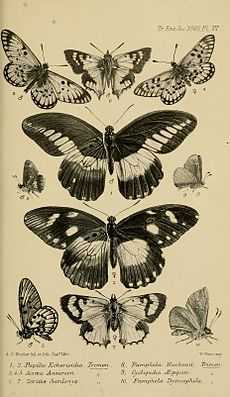Papilio echerioides
| White-banded Swallowtail | |
|---|---|
 | |
| Scientific classification | |
| Kingdom: | Animalia |
| Phylum: | Arthropoda |
| Class: | Insecta |
| Order: | Lepidoptera |
| Family: | Papilionidae |
| Genus: | Papilio |
| Species: | P. echerioides |
| Binomial name | |
| Papilio echerioides Trimen, 1868[1] | |
| Synonyms | |
| |
The White-banded Swallowtail (Papilio echerioides) is a butterfly of the Papilionidae family. It is found in Subsaharan Africa.
The wingspan is 65–75 mm. Has two flight periods from January to March and September to November.[2]
The larvae feed on Clausena inaequalis, Toddalia lanceolata, Toddalia asiatica, Zanthoxylum capense, Zanthoxylum delagoense, Vepris lanceolata and Citrus spp.[1]

Description
Male very similar to Papilio cynorta , but the median band, which is very pale yellow, tapers more strongly towards the apex. The pale spot in area (cell) 6 of the forewing is always present (usually absent in cynorta ). The female is a mimic of Amauris echeria Stoll and of Amauris albimaculata Butler (Danaidae).The forewing is black with white spots, the hindwing black with a large pale ochreous discal area and white submarginal spots.
Taxonomy
Papilio echerioides is a member of the echerioides species-group. This clade includes
- Papilio echerioides Trimen, 1868
- Papilio fuelleborni Karsch, 1900
- Papilio jacksoni Sharpe, 1891
- Papilio sjoestedti Aurivillius, 1908
Subspecies
Listed alphabetically.[1]
- P. e. ambangulu Clifton & Collins, 1997 (Tanzania)
- P. e. chirindanus van Son, 1956 (Mozambique (Mount Gorongosa), eastern Zimbabwe)
- P. e. echerioides Trimen, 1868 (South Africa, Swaziland)
- P. e. homeyeri Plötz, 1880 (Angola, Democratic Republic of Congo, south-western Tanzania, northern Zambia)
- P. e. joiceyi Gabriel, 1945 – Zoroaster Swallowtail (Sudan, Uganda, western Kenya, western Tanzania, Rwanda, Democratic Republic of Congo)
- P. e. kiellandi Clifton & Collins, 1997 (southern Kenya, northern Tanzania)
- P. e. leucospilus Rothschild, 1902 (Ethiopia: highlands south-east of Rift Valley)
- P. e. nioka (Hancock, 1989) (Democratic Republic of Congo)
- P. e. nyiro Carcasson, 1962 (Kenya)
- P. e. oscari Rothschild, 1902 (Ethiopia: highlands west of the Rift Valley)
- P. e. pseudowertheri Kielland, 1990 (eastern and south-eastern Tanzania)
- P. e. shirensis (Hancock, 1987) (Malawi)
- P. e. wertheri Karsch, 1898 (eastern Kenya, eastern and northern Tanzania)
- P. e. zoroastres Druce, 1878 (Cameroon)
References
| Wikimedia Commons has media related to Papilio echerioides. |
| Wikispecies has information related to: Papilio echerioides |
- Carcasson, R.H, 1960 The Swallowtail Butterflies of East Africa (Lepidoptera,Papilionidae). Journal of the East Africa Natural History Society pdf Key to East Africa members of the species group, diagnostic and other notes and figures. (Permission to host granted by The East Africa Natural History Society